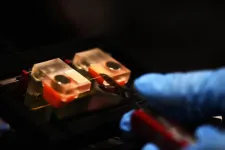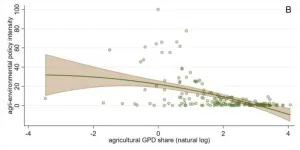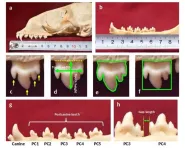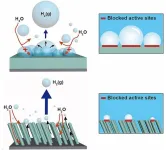Toughening has always been an important research direction of structure ceramics. The addition of secondary phases to the ceramic matrix to prepare composite ceramics is an effective toughening pathway in the field of structure ceramics. Both phase-type and microstructure of the secondary phases play a decisive role in the toughening effect of the ceramic matrix. Being different from the conventional independent phase as the secondary phase, B4C@TiB2 core–shell structural unit has been purposely designed as an innovative kind of secondary phase to toughen the Al2O3 ceramic matrix, providing a new concept for the toughening studies of structural ceramics.
A team of material scientists led by Zhixiao Zhang from Hebei University of Engineering in Handan, China recently prepared successfully a kind of Al2O3 composite ceramics toughened by B4C@TiB2 core–shell structural units consisting of the B4C core enclosed by the TiB2 shell. The core–shell structural units serving as the composite toughening phase of Al2O3 ceramics can break through the current toughening bottleneck of Al2O3 composite ceramics toughened using independent phases, and realize the further improvement for the fracture toughness of Al2O3 ceramics.
The team published their work in Journal of Advanced Ceramics on January 2, 2024.
“In this work, we prepared Al2O3 composite ceramics toughened by B4C@TiB2 core–shell structural units through a combination of molten salt methodology and spark plasma sintering. Unlike conventional setups where TiB2 and SiC remain isolated and independently dispersed in Al2O3 ceramic matrix, the two secondary phases in this Al2O3 composites constitute core–shell composite structures which can induce multi-dimensional synergistic toughening behavior. The toughening effect produced by core-shell structural units is impossible to achieve by independent phases.” said Dr. Zhixiao Zhang, the corresponding author of the paper, a professor in the College of Materials Science and Engineering at Hebei University of Engineering. Professor Zhang is also the Top Talent in Hebei Province of China and vice Dean of the College of Materials Science and Engineering at Hebei University of Engineering.
The B4C@TiB2 core–shell toughening units consist of a micron-sized B4C core enclosed by a shell approximately 500 nm thick, composed of numerous nanosized TiB2 grains. The regions surrounding these core–shell units exhibit distinct geometric structures and encompass multidimensional variations in the phase composition, grain dimensions, and thermal expansion coefficients. Consequently, intricate stress distributions emerge, thereby fostering the propagation of cracks in multiple dimensions. This behavior consumes a considerable amount of crack propagation energy, thereby enhancing the fracture toughness of the Al2O3 ceramic matrix. The resulting Al2O3 composite ceramics yield an improved fracture toughness up to 6.92 MPa·m1/2.
“This novel concept and the corresponding toughening mechanism of utilizing core–shell structural unit as a secondary phase to enhance ceramic matrix toughness can provide a new perspective and theoretical foundation for the toughening research of other structural ceramics.” Zhixiao Zhang said.
The next step is to expand the shape and phase composition of core–shell structural units, including core–shell structural particles, whiskers, fibers, tubes, or plates, which consist of various phase types. Also, these core–shell structural units can be further extended to toughen a variety of structure ceramics, such as B4C, TiB2, SiC, etc. Meanwhile, a systematical study on the toughening mechanism of core-shell structural units as composite toughening phases will be performed. The ultimate goal is to develop a new toughening theoretical system based on core–shell units toughening ceramic matrix.
Other contributors include Yingjie Shi, Weixing Li, Xiaorong Zhang, Jiachao Jin, Jingbo Mu, Guangsuo Wang, and Xiaoliang Zhang from Hebei University of Engineering, Handan, China; Jilin Wang from Guilin University of Technology, Guilin, China; Yu Dong from Curtin University, Perth, Australia.
This work was financially supported by the Natural Science Foundation of Hebei Province (Nos. E2021402004, F2020402010, and E2020402075), Central Government Guided Local Science and Technology Development Fund Project (No. 226Z1101G), Three Talent Project of Hebei Province (No. A202101019), and Postgraduate Innovation Ability Training Funding Project of Hebei Province (No. CXZZSS2023120).
About Journal of Advanced Ceramics
Journal of Advanced Ceramics (JAC) is an international journal that presents the state-of-the-art results of theoretical and experimental studies on the processing, structure, and properties of advanced ceramics and ceramic-based composites. JAC is Fully Open Access, monthly published by Tsinghua University Press on behalf of the State Key Laboratory of New Ceramics and Fine Processing (Tsinghua University) and the Advanced Ceramics Division of the Chinese Ceramic Society. JAC has been indexed in SCIE (IF = 16.9, top 1/28, Q1), Scopus, and Ei Compendex.
About SciOpen
SciOpen is a professional open access resource for discovery of scientific and technical content published by the Tsinghua University Press and its publishing partners, providing the scholarly publishing community with innovative technology and market-leading capabilities. SciOpen provides end-to-end services across manuscript submission, peer review, content hosting, analytics, and identity management and expert advice to ensure each journal’s development by offering a range of options across all functions as Journal Layout, Production Services, Editorial Services, Marketing and Promotions, Online Functionality, etc. By digitalizing the publishing process, SciOpen widens the reach, deepens the impact, and accelerates the exchange of ideas.
END





